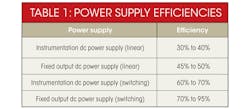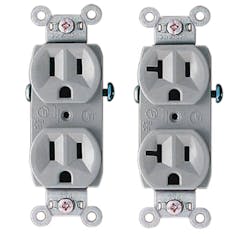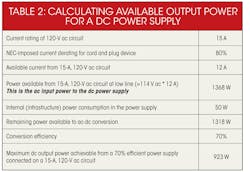When you need 2000 W of dc power for your testing, you may not think too much about where it will come from. The ac line always seems able to provide enough. But in the United States, when operating from the typical and ubiquitous 120-V ac outlet, you might not get enough power off the ac line to generate 2000 W or even 1000 W out of your dc power supply. How can that be?
Historically, power supplies for testing applications were linear and thus were limited by size and weight to a few hundred watts. Over time, switching power supplies and other power supply design innovations made dc power supplies much smaller and more efficient. A 2000-W switching power supply is small enough to put on your desktop, but you may be surprised that you can’t simply plug it into the nearest 120-V ac outlet because it can’t provide enough power into the supply to get 2000 W out.
This file type includes high resolution graphics and schematics.
Related Articles
• What Is An Autoranging Power Supply?
• Bipolar Power Supplies Run The Voltage Gamut
• Conquer The Challenges Of High-Current Pulses
In North and South America, Japan, Taiwan, and a few other spots around the globe, ac line voltages are 100 to 120 V ac. In other parts of the world, you have 220 to 240 V ac, meaning you can get twice the power at the same line current. For the rest of this article, I’ll stick to talking about the 120 V ac of the United States.
Look At The Specs
Let’s look at efficiency, which is defined as dc power out over ac power in. Table 1 lists efficiencies for several different types of power supplies. Note that internal functions such as the CPU, cooling fans, I/O, and display consume some of the power for instrumentation power supplies. On a modern power supply, these functions could total 25 to 100 W. This fixed usage will degrade the overall efficiency of the power supply, so it needs more ac power in to get the desired dc power out.
A power supply vendor has to set the required ac line current based on the output power of the supply, its efficiency, and any power consumed internally by its infrastructure. The required ac line current will be the input power divided by 120 V. It could exceed the available line current from a 120-V ac outlet.
Common home or building wiring will have either a 15-A or a 20-A ac receptacle (see the figure). You might think that a power supply will then be limited to either 15 A or 20 A of input current, depending on which receptacle it is plugged into. But the power supply vendor will most likely follow the limitations as expressed by the National Electrical Code (NEC).
Since most people will want to be able to unplug their power supply from the wall and move it to another location, the power supply qualifies as “cord and plug connected equipment not fastened in place.” According to the NEC, cord and plug connected equipment cannot draw more than 80% of the circuit rating. That means the 15 A receptacle is valid to deliver only 12 A, or 1440 W into the power supply. Furthermore, the power supply vendor will have to account for low ac line voltage, which can go as low as 114 V ac. At 114 V ac, the available total ac power is only 1368 W (=114 V ac * 12 A).
But what about your hair dryer that’s rated at 1800 W? An electrical device vendor may choose to set its maximum current ratings based on factors other than the NEC. A safety agency, like UL, will permit higher line currents (but never more than 15 A on a 15-A circuit). The power supply vendor may choose to follow the NEC to be more conservative.
Table 2 details the expected dc output power be for a sample dc source, taking into account ac line current limitations and power supply efficiency. As you can see, you may only be able to get 923-W dc output. The alternative to get more dc output power is to design the supply to run from a higher voltage, such as 208 V ac, which raises the available input power. While this does provide more power, it also creates an inconvenience for the user, as you need a different, and less common, ac circuit to power the supply.
An innovative solution is found on Agilent’s N6700 series dc power supplies. To achieve full output power in the U.S., 208-V ac input is required, but this means you need the less common 208-V ac circuit. So Agilent went a step further: the supply is designed so you can also plug it into the common 15-A, 120-V ac outlet.
When the supply’s universal input senses that it is plugged into 120 V ac, it automatically limits its output power so its input power will not demand more than 12 A, which is what the NEC says you can draw from the common 15-A, 120-V ac receptacle. So while it can’t operate at full power, it can still operate, allowing the user to simply plug in and temporarily use the supply, albeit with some limitations, without having to find a 208-V ac outlet.
This file type includes high resolution graphics and schematics.
Bob Zollo is a product planner with the System Products Division, Electronic Measurements Group, at Agilent Technologies. He is responsible for creating Agilent’s power products roadmap by researching customer and industry trends and developing product plans to meet emerging customer needs. He holds a degree in electrical engineering from Stevens Institute of Technology in Hoboken, N.J.





